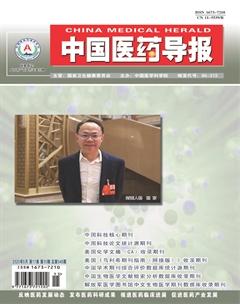影响促排卵周期人工授精临床妊娠率的因素分析
周知 马宁 涂志华 李海波


[摘要] 目的 分析影響促排卵周期宫腔内人工授精(IUI)成功率的因素。 方法 回顾性分析2015年7月~2017年6月在海南省妇幼保健院和南京医科大学附属苏州医院行促排卵IUI的500个周期及其患者的临床资料,探讨女性年龄、不孕年限、IUI周期次数、每个周期中的IUI次数、促排卵方案、优势卵泡数目、人绒毛膜促性腺激素(HCG)诱导排卵与否等指标与临床妊娠率的相关性,通过logistic回归分析确定IUI临床妊娠率的独立影响因素。 结果 经过IUI共有117例患者成功妊娠,妊娠率为23.40%;单因素分析结果显示,女性年龄和优势卵泡数目对于IUI临床妊娠率有显著影响(P < 0.05),而不孕年限、IUI周期次数、每个周期中的IIUI次数、促排卵方案、HCG诱导排卵与否对于IUI临床妊娠率无影响(P > 0.05)。logistic回归分析显示,女性年龄(OR = 2.128、95%CI:1.018~4.162,P < 0.05)和优势卵泡数目(OR = 3.617、95%CI:0.855~7.282,P < 0.05)是促排卵周期IUI临床妊娠率的独立影响因素。 结论 女性年龄和优势卵泡数目是影响促排卵周期IUI临床妊娠率的关键因素,年龄是危险因素,优势卵泡数目是保护因素。
[关键词] 人工授精;促排卵;临床妊娠率;危险因素;保护因素
[中图分类号] R711.4 [文献标识码] A [文章编号] 1673-7210(2020)05(c)-0104-04
Analysis on the factors affecting the pregnancy rate of ovulatory cycle artificial insemination
ZHOU Zhi1 MA Ning1 TU Zhihua1 LI Haibo2
1.Hainan Maternal and Child Health Hospital, Hainan Province, Haikou 570206, China; 2.Suzhou Hospital Affiliated to Nanjing Medical University, Jiangsu Province, Suzhou 215000, China
[Abstract] Objective To analysis the influencing factors of success rate of intrauterine artificial insemination (IUI) in ovulation-promoting cycle. Methods A retrospective analysis of 500 cycles of ovulation-promoting IUI and clinical data of patients at Hainan Maternal and Child Health Hospital and Suzhou Hospital Affiliated to Nanjing Medical University from July 2015 to June 2017, the female age, infertility years, IUI cycle, the number of IUI times per cycle, the number of ovulation inducing scheme, the number of dominant follicles, and whether or not human chorionic gonadotropin (HCG) inducing ovulation and its correlation with the clinical pregnancy rate were explored. The independent factors affecting clinical pregnancy rate of IUI were analyzed by logistic regression analysis. Results A total of 117 patients were successfully pregnant after IUI, with a pregnancy rate of 23.40%. The univariate analysis showed that the effect of female age and the number of dominant follicles on the clinical pregnancy rate of IUI was significant (P < 0.05), there were no statistically significant differences in the effects of infertility years, IUI cycles, the number of IUI in each cycle, the ovulation-promoting regimen, and whether or not HCG induced ovulation on the clinical pregnancy rate of IUI (P > 0.05). logistic regression analysis showed that the age of women (OR = 2.128, 95%CI: 1.018-4.162, P < 0.05) and the number of dominant follicles (OR = 3.617, 95%CI: 0.855-7.282, P < 0.05) were independent influencing factors of the clinical pregnancy rate of IUI in the ovulation-promoting cycle. Conclusion Female age and the number of dominant follicles are key factors in the clinical pregnancy rate of the IUI during the ovulation-promoting cycle, age is a risk factor, and the number of dominant follicles is a protective factor.
[Key words] Artificial insemination; Stimulate ovulation; Clinical pregnancy rate; Risk factors; Protective factors
近年来,不孕不育的患者夫妇数量持续增长,其原因涉及多个方面,包括生活环境的改变、不良饮食习惯以及初次性生活年龄越来越小等,这也促使我国辅助生殖技术(assisted reproductive technology,ART)快速发展,需要借助ART助孕的患者亦越来越多[1]。人工授精是辅助生殖技术中的一线治疗方案,最常用的是宫腔内人工授精(intrauterine artificial insemination,IUI)[2]。针对存在排卵障碍的患者,与自然周期比较,促排卵IUI的妊娠率较高[3],但与体外受精-胚胎移植比较,妊娠率仍然偏低[4],因此有必要对IUI妊娠率的相关影响因素进行研究,旨在为提高IUI的妊娠率提供理论依据。本研究通过回顾性分析促排卵IUI的500个周期,探讨影响IUI临床妊娠率的相关因素,现报道如下:
1 对象与方法
1.1 研究对象
选取2015年7月~2017年6月海南省妇幼保健院与南京医科大学附属苏州医院实施促排卵周期IUI的共500个周期及患者资料进行回顾性分析。本研究经受检夫妇知情并签字同意,经医院医学伦理委员会批准。纳入标准:①夫妇婚后1年以上,无避孕措施未怀孕,女性输卵管碘油造影或腹腔镜检查显示至少有一侧输卵管通畅。②女性经阴道超声检测卵泡发育异常或无排卵,但基础促卵泡生成素(FSH)、雌二醇(E2)、泌乳素(PRL)水平正常。③其他常见不孕原因:女性的宫颈因素,男方的轻度少精、弱精、精子液化异常、性交障碍等。排除标准:女性确诊为子宫内膜异位症。
1.2 方法
1.2.1 治疗方案 500个周期均采用促排卵IUI。
1.2.2 促排卵方案的选择原则 ①克罗米芬(上海衡山药业有限公司,H31021107,c0804)50 mg/d,共5 d,口服。②来曲唑(江苏恒瑞医药股份有限公司,H19991001, 15112557)2.5 mg/d,共5 d,口服。③服用药物后无优势卵泡,则改用尿促性素(丽珠医药集团股份有限公司,H10940097,151101),于月经周期第5天开始,37.5~75 U/d,共7 d,根据卵泡发育情况调整剂量。④如果经过以上方案均无优势卵泡,则在下1个周期直接以尿促性素开始治疗;或者在月经周期第9~11天仍无优势卵泡时,直接以尿促性素开始治疗。
1.2.3 IUI的时机选择 优势卵泡直径≥16 mm时,于LH峰值后的24 h内进行IUI;如果卵泡直径≥20 mm且仍未出现尿LH峰值,则注射人绒毛膜促性腺激素(HCG),24~36 h后予IUI。
1.2.4 黄体支持与妊娠随访 排卵后第2天开始给予达芙通(B.V,H20020632,347894)20 mg,2次/d,口服,共14 d后查HCG,阳性者为生化妊娠[5];35 d后经B超检测发现妊娠囊者为临床妊娠[6]。
1.3 观察指标
检测不同年龄(<30岁=1、30~35岁=2、>35~40岁=3和>40岁=4)、不孕年限(1~3年=1、>3~5年=2和 >5年=3)、IUI周期次数(1次=1、2次=2、3次=3和>3次=4)、每个周期中的IUI次数(1次=1、2次=2和>2次=3)、促排卵方案(克罗米芬=1、来曲唑=2、克罗米芬+尿促性素=3、来曲唑+尿促性素=4、尿促性素=5)、优势卵泡数目(1、2、3个)、HCG诱导排卵与否(是=0、否=1)等对于促排卵周期数目及临床妊娠结局的影响。
1.4 统计学方法
采用SPSS 19.0统计学软件进行数据分析,计量资料用均数±标准差(x±s)表示,两组间比较采用t检验;计数资料用例数及百分率表示,组间比较采用χ2检验。促排卵周期IUI妊娠率的独立影响因素采用logistic回归分析。以P < 0.05为差异有统计学意义。
2 结果
2.1 一般资料及IUI妊娠情况
女性年龄22~46岁,不孕年限1~12年,500个促排卵周期中,经过IUI共有117个成功妊娠,妊娠率为23.40%。
2.2 影响促排卵周期IUI妊娠率的单因素分析
不同女性年龄、优势卵泡数目患者的IUI妊娠率比较,差异有统计学意义(P < 0.05),而不孕年限、IUI周期次数、每个周期中的IUI次数、促排卵方案、HCG诱导排卵与否患者IUI妊娠率比较,差异无统计学意义(P > 0.05)。见表1。
2.3 促排卵周期IUI妊娠率独立影响因素的logistic回归分析
以单因素分析中差异有统计学意义的女性年龄、优势卵泡数目为自变量,以IUI妊娠率为因变量进行多因素logistic回归分析。结果显示,女性年龄和优势卵泡数目是促排卵周期IUI妊娠率的独立影响因素(P < 0.05)。见表2。
3 討论
IUI因其操作简单、费用低、并发症少、患者易接受等原因,已经广泛应用于不孕症的治疗中,但目前IUI成功率仍然较低,影响IUI的因素有很多。精液经处理后注入宫腔,提高了精子的密度,增加了到达受精部位的精子数,提高了精子的运动质量,克服了宫颈的不利因素,去除了精浆中有抑制精子活动作用的成分(免疫职能细胞和抗精子抗体),避免了精浆中前列腺素与子宫的接触,防止因宫缩和腹痛致使精液流出。除此之外,对于女性因素在IUI成功率中的影响,目前知之甚少。
本研究結果显示,不孕年限、IUI周期次数、每个周期中的IUI次数、促排卵方案和HCG诱导排卵与否等均未对促排卵IUI的妊娠率构成影响。国外学者报道[7],不孕年限为1、2、3、4年的患者妊娠率分布在9~12%的较低范围内,相互之间差异并不显著,可能的原因是1年以上的不孕患者其病因均较为复杂,因而有学者建议4年以上的不孕患者可考虑采用体外受精-胚胎移植之类的更为高级的辅助生殖技术[8]。国内的学者指出[9],增加IUI的周期次数,并不提高临床妊娠率;甚至有文献指出[10],只有第1个周期和第2周期的临床妊娠率稍高,之后便开始下降,因此多数学者主张第2周期临床妊娠失败者也需考虑体外受精-胚胎移植[11]。有关IUI的次数是否增加临床妊娠率,在一项研究中发现[12],当有多个优势卵泡发育时,比较注射HCG后36 h的单次IUI与注射HCG后18 h和40 h的双次IUI,其临床妊娠率并无明显差异,所以可以认为IUI的次数并不增加临床妊娠率。目前,临床上认为促排卵治疗可以增加排卵障碍患者的IUI妊娠率,但是仍缺乏循证医学证据,以及不同的促排卵方案是否存在差异尚有争议。而有专家指出[13],促排卵治疗的IUI妊娠率比自然周期高只与多卵泡发育有关,并非不同的治疗方案导致。最后,HCG诱导排卵能否提高临床妊娠率也无定论,有学者认为HCG诱导排卵获得的成熟卵子更多[14],也有学者认为自然排卵状态下子宫内膜的容受状态更有利于妊娠[15]。
本研究通过logistic回归分析后最终得出,女性年龄和优势卵泡数目是IUI临床妊娠率的独立影响因素。尤其需要指出的是,年龄是危险因素,优势卵泡数目是保护因素。国外研究也显示[16],女性年龄在IUI临床妊娠率中具有重要作用,>35岁患者的临床妊娠率开始降低,且随着年龄的增加越来越低。这主要是因为卵巢生长的不可逆性决定的,随着年龄的增加,卵母细胞的功能逐渐下降,所以对于>35岁的患者,也不宜随意给予促排卵治疗。临床发现[17-18],当有2个以上优势卵泡的时候,妊娠率明显提高。促排卵治疗可以增加排出的优势卵泡数目,与精子结合的机会大大增加,所以更加进一步提高了临床妊娠率[19-20]。
综上所述,本研究认为,女性年龄和优势卵泡数目是影响促排卵IUI临床妊娠率的主要因素。在使用促排卵IUI的时候,需对患者进行合理评估,特别是对于女性年龄较大的患者,在促排卵治疗方案失败后需考虑其他治疗。
[参考文献]
[1] Whittaker A,Inhorn MC,Shenfield F. Globalised quests for assisted conception:Reproductive travel for infertility and involuntary childlessness [J]. Glob Public Health,2019,14(12):1669-1688.
[2] Bonow MP,Donne RDD,Rosa VBD,et al. Intrauterine insemination as a primary viable option to infertile couples:evaluation of patients in a private center [J]. JBRA Assist Reprod,2019,23(4):328-332.
[3] Soysal C,Ozmen U. Intrauterine insemination in ovulatory infertile patients [J]. Niger J Clin Pract,2018,21(10):1374-1379.
[4] Liao S,Xiong J,Tu H,et al. Prediction of in vitro fertilization outcome at different antral follicle count thresholds combined with female age,female cause of infertility,and ovarian response in a prospective cohort of 8269 women [J]. Fertil Steril,2019,98(41):e17470.
[5] Pakniat H,Bahman A,Ansari I. The Relationship of Pregnancy-Associated Plasma Protein A and Human Chorionic Gonadotropin with Adverse Pregnancy Outcomes:A Prospective Study [J]. J Obstet Gynaecol India,2019,69(5):412-419.
[6] Pulliainen H,Niela-Vilén H,Ekholm E,et al. Experiences of interactive ultrasound examination among women at risk of preterm birth:a qualitative study [J]. Bmc Pregnancy Childbirth,2019,19(1):338.
[7] Butcher MJ,Janoo J,Broce M,et al. Use of Sperm Parameters to Predict Clinical Pregnancy with Intrauterine Insemination [J]. J Reprod Med,2016,61(5-6):263.
[8] 陈立雪,李蓉,叶荣伟.中国妇女体外受精-胚胎移植累计活产率分析[J].中国生育健康杂志,2017,28(2):101-105.
[9] 陈娟,张真珍,付琴,等.宫腔内人工授精妊娠结局及妊娠成功率的影响因素研究[J].河北医药,2017,39(18):2821-2823.
[10] Ghasemi M,Kordi M,Asgharipour N,et al. The effect of a positive reappraisal coping intervention and problem-solving skills training on coping strategies during waiting period of IUI treatment:An RCT [J]. Int J Reprod Biomed,2017,15(11):687-696.
[11] Bouet PE,May-Panloup P,Descamps P. Letter to the editor/comments on "the conversion to IUI versus continuance with IVF in low responder patients [J]. Eur J Obstet Gynecol Reprod Biol,2019,232:106.
[12] Danhof NA,van Wely M,Repping S,et al. Follicle stimulating hormone versus clomiphene citrate in intrauterine insemination for unexplained subfertility:a randomized controlled trial [J]. Hum Reprod,2018,33(10):1866-1874.
[13] Kaur J,Suri V,Gainder S,et al. Prospective randomized trial comparing efficacy of letrozole step-up protocol with letrozole plus gonadotropins for controlled ovarian stimulation and intrauterine insemination in patients with unexplained infertility [J]. Arch Gynecol Obstet,2019,5(1):20-25.
[14] Vichinsartvichai P,Traipak K,Manolertthewan C. Performing IUI Simultaneously with hCG Administration Does Not Compromise Pregnancy Rate:A Retrospective Cohort Study [J]. J Reprod Infert,2018,19(1):26-31.
[15] 王娟,孟敏華,李明杰.不同促排卵方案对宫腔内人工授精妊娠结局影响研究[J].中国妇幼健康研究,2017, 28(5):565-566.
[16] Lee J,Hwang S,Lee J,et al. Effect of insemination timing on pregnancy outcome in association with female age,sperm motility,sperm morphology and sperm concentration in intrauterine insemination [J]. J Obstet Gynecol Re,2018,44(6):1100-1106.
[17] 朱娟,马燕琳,黄元华,等.2140例不孕患者夫精宫腔内人工授精的临床效果及其影响因素[J].山东医药,2017, 57(19):1-4.
[18] Xueli L,Yu P,Fang C,et al. Analysis of clinical pregnancy outcomes of infertile patients undergoing natural cycles and stimulate ovulation cycles of intrauterine artificial insemination by husband [J]. Chin J Obstet Gynecol Ped,2017,4(2):1673-5250.
[19] Borges E,Zanetti BF,Setti AS,et al. FSH dose to stimulate different patient′ ages:when less is more [J]. JBRA Assist Reprod,2017,21(4):336-342.
[20] Li HR,Li Y,Liu Y,et al. Expression and regulation of high mobility group AT-hook 1(HMGA1) during ovulation and luteinisation in rat ovary [J]. Reprod Fert Develop,2019,31(4):698-704.
(收稿日期:2019-10-25 本文编辑:任 念)

